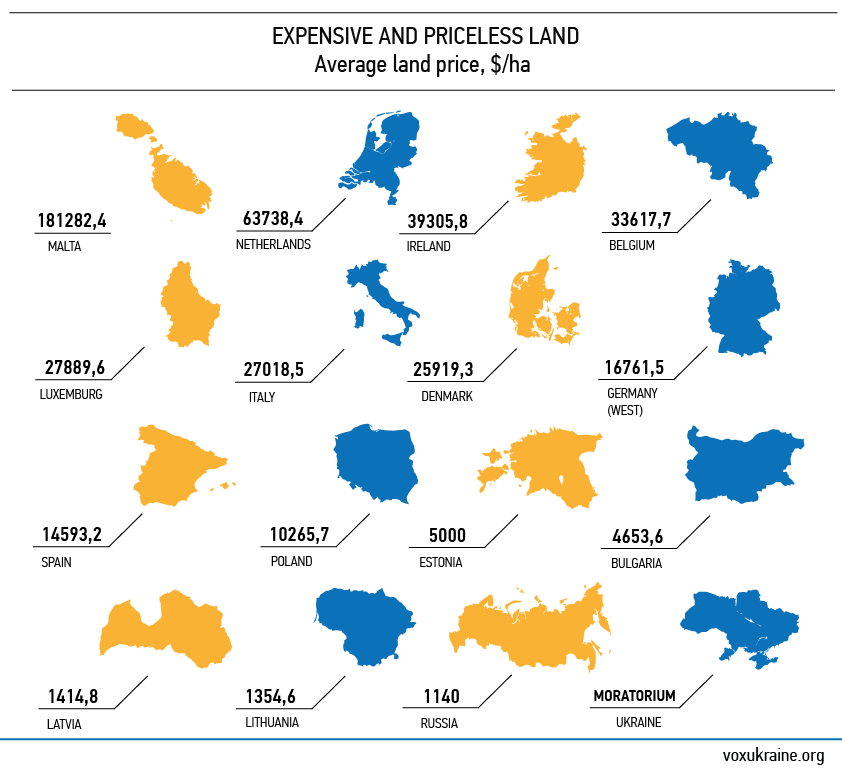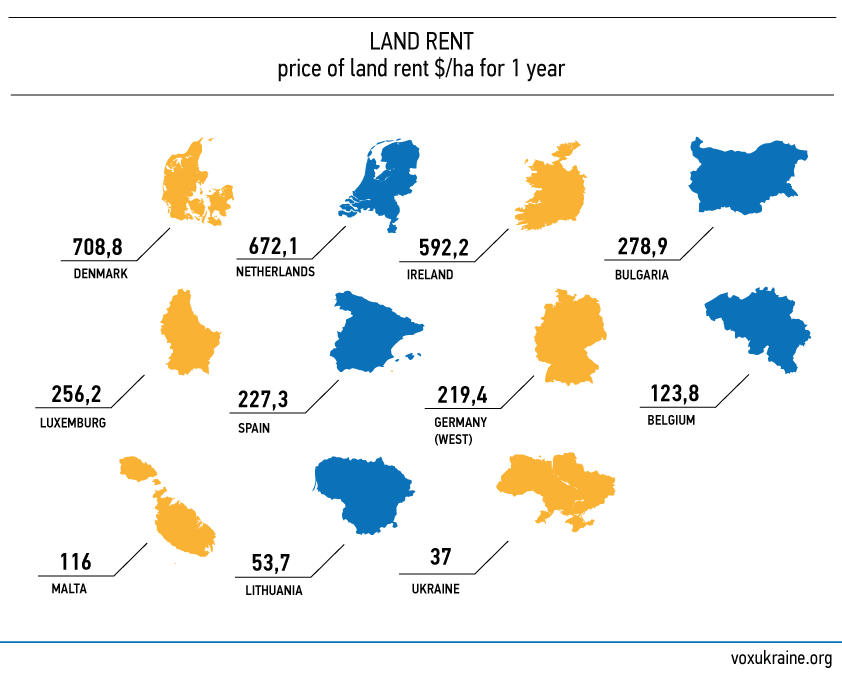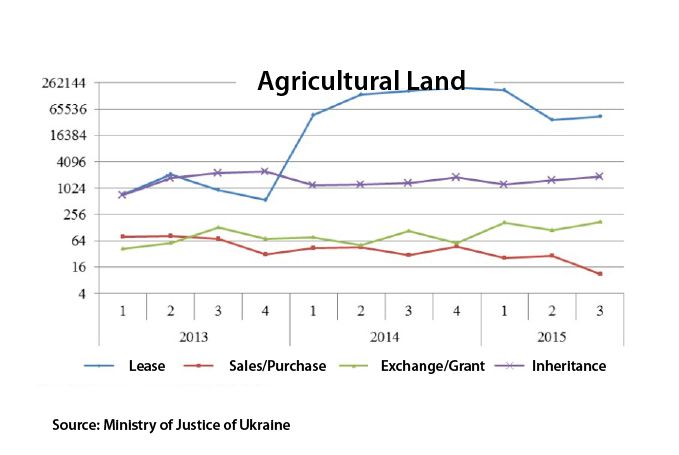The moratorium on the agricultural land market has been in place for more than 16 years. However, much of society is still opposed to the lift of the moratorium, despite the fact that this solution promises to improve the situation of millions of Ukrainians.
On February, 17, a group of MPs registered a submission to the Constitutional Court on the lift of the moratorium on land sale. “In six months, the Court will be able to lift the moratorium and de jure launch the market for land,” says Oleksiy Mushak, one of the initiators of the submission. “At least five clauses of the Constitution were violated, the essential one being the violation of property rights consisting of three parts: ownership, use, and disposal of land. The latter is the one Ukrainian citizens are deprived of.”
The video of the protest against the lift of the moratorium near the Constitutional Court
It is worth mentioning that the first time the Verkhovna Rada introduced the moratorium was in January of 2001. MP Anatoliy Matviyenko was the initiator of this decision. The law provided that the moratorium will operate temporarily up to the adoption of the law on turnover of farmland or a relevant provision in the Land Code. Later in 2001, the Rada passed the Land Code, which did not stipulate the lift of the moratorium. Quite the opposite, the law prolonged its operation until the end of 2005. Afterwards, the moratorium was prolonged eight more times: in 2004, 2006, 2008, 2010, 2011, 2012, 2015, and last time in 2016 – until January 1, 2018.
During 16 years of the moratorium, the land issue has become one of the most speculative political slogans and generated dozens of myths. VoxUkraine focuses on popular “land myths” and analyses how reliable they are.
Myth 1. Upon the lift of the moratorium, land will be bought on the cheap from the villagers
“The investor will take it from poor people at a cheap rate,” Oleg Lyashko (October of 2016).
According to research by Kyiv International Institute of Sociology, only one in six Ukrainians supports the lift of the moratorium. The top fears of land share owners include low land prices, pressure on owners to sell the land, and fraudulent schemes of land purchase. Paradoxically, however, more than ½ of the interviewed Ukrainians in general and more than ⅓ of land share owners expect the lift of the moratorium to benefit the economy of the country.
In fact, it is the moratorium that “steals” up to 90% of potential income from 6.9 million of land share owners each year, particularly due to low land prices, which are among the lowest in Europe. According to calculations by agricultural sector experts Oleg Nivievskyi and Denys Nizalov, the average agricultural land price in Ukraine in 2015 was more than 10 times lower than the fair market rate. According to the data provided by the State Service for Geodesy, Cartography and Cadastre, the average land rate in 2015 was $37/ha. The main reasons for that were the moratorium on land sales, the high rate of land bank maintenance, and poor access to funding. According to the experts, if the markets and agents of production worked properly, the land rate would amount to $455/ha.

In the countries of Central and Eastern Europe, land price and land rate started growing right after the market for land was opened up in the 1990s. The annual land rate increase was around 20%. Nowadays, the average land rate of 1 ha in Hungary is $100-150, while in Bulgaria it is $279. Land in Western Europe is even more expensive: it costs $700-750 in Denmark and $600-650 in the Netherlands.

Myth 2. Foreigners will buy all the land and will use it inefficiently
“It is not Ukrainians who will be owners of the land… If a market for land is introduced, it will be a highway robber, not an investor who will come,” Oleg Lyashko (October of 2016).
This is definitely one of the most popular political myths. However, it has nothing to do with the real situation. First of all, the Land Code restricts the buying audience for farmland to Ukrainian citizens and legal entities that are engaged in agricultural production.
However, the experience of neighbouring countries also proves this myth to be a gross exaggeration at best. First, the vast majority of countries opened the market to citizens and resident legal entities alone in the first 5-10 years of the market liberalisation. For example, in Poland, Romania, and Estonia foreigners and foreign legal entities were long forbidden to purchase land. In the Czech Republic, foreigners were not entitled to purchase land until 2011. In Slovakia, it was only in 2014 that foreigners acquired the right to purchase land. Croatia has not opened the land market for non-residents yet.
Ukraine is also going to introduce similar restrictions: a draft law on the turnover of farmland submitted to the Verkhovna Rada has similar qualifications regarding the participation of foreign funds in the buying and selling of agricultural land.
Secondly, it is rather doubtful that foreigners will be able to buy up a significant part of land property in a short time. Take Slovakia as an example.
“In Slovakia, the moratorium (for foreigners – VoxUkraine) was lifted two years ago – and nothing happened. Only 5-7% of all land is owned by foreigners,” explains Ivan Mikloš, co-chair of the Group of Strategic Advisors for the Support of Reforms in Ukraine under the Cabinet of Ministers and former Minister of Finance of the Slovak Republic.
Third, closing the market for foreigners is a bad idea since it may have a negative impact on the value of land. A research on “Restrictions on farmland sales markets: a survey of international experience and lessons for Ukraine” notes that restrictions on the land ownership or turnover, including a ban on sales to foreigners, decrease the demand which results in price reduction. “Isolating the Ukrainian farmland market from foreigners will cause losses for land shares owners,” point out the authors of the survey.
That was the case of the Canadian province of Saskatchewan in 1974. The province introduced farmland ownership restrictions for non-residents. As a result, the land price dropped anywhere from $10-85/ha.
There is one more point to mention. It is the moratorium and lease relations that encourage inefficient use of land. Pavlo Kulinich, an expert in agrarian legislation, studied the experience of Germany, France, Poland, and the Netherlands and came to the conclusion that the right to private property is crucial for land preservation. Farmers who bought land at their own expense preserve it since it is their major asset for farming.
Myth 3. Agricultural holdings will quickly buy up most of the land
“Our chernozem soils will fall into the hands of either oligarchs and financial-industrial groups, or multinational corporations,” Viktor Medvedchuk (March of 2016).
The opposite is true. The experience of neighbouring countries Poland, the Czech Republic and Slovakia, has proven that the free market facilitates the development of small and medium-sized agricultural business.
One way to promote the development of farm business is to restrict the land size eligible to be owned by one person. For example, in Poland, the law restricts the owned land size up to 500 ha. In Hungary, the upper limit of the amount of land owned by an individual is 300 ha, while the area which may be in use is 1.200 ha. In Slovakia, the average size of a private plot of land is 0.45 ha.
Even in the countries with no land size ownership restrictions, many thousands of farm enterprises have been opened. For example, in Finland, there are more than 30 thousand farm enterprises alone and more than 100 thousand agricultural enterprises in total.
Secondly, the creation of a market does not mean all lands will immediately go on sale. In France, 75% of land is used on a leasehold basis, while the average size of land for a sale transaction is 3.3 ha. In Sweden in 2005, 85% of transactions of purchase and sale were settled for land plots less than 10 ha, despite the fact that 40% of land is on lease.
In Ukraine, the situation is completely different. It is not the market that sets the land price. The price is defined based on the normative monetary value evaluation, which can be either lower or higher than the market price. Low rental rates enable agricultural holdings to accumulate large areas of the land bank. “Large agricultural holdings find it much more advantageous to lease land at a cheap rate than to buy it at the market price or pay rent based on the market value,” writes Sergiy Hlan, an MP from the Petro Poroshenko Block.
Due to the moratorium, agricultural companies were able to accumulate large areas of the land banks. Although there are more than 50.000 companies in the agro-industrial complex, the market is monopolised: the 100 largest companies lease 6.5 million ha of arable land (20% of the total land fund). At the same time, the ten largest companies lease from 125 to 654 thousand ha. In fact, the moratorium encourages the development of agricultural holdings, since they alone have the access to financial resources. Farmers cannot take a loan against land, and it hinders the development of their business.
Finally, the majority of agricultural holdings are overindebted and do not have available financial resources for the purchase of all the land bank they lease now. On the other hand, it is physically impossible to complete such a number of transactions of purchase and sale of land plots due to two reasons. First, the system of land registration is able to process up to 800 thousand agreements per year. In 2014, the system was already working at its full capacity. Second, a high fragmentation of land hinders the process of purchase and sale: the average size of each plot is 3.6 ha, which equals to 270 thousand plots per 1 million ha of land.
Figure. The number of transactions with agricultural land in 2013 – 3 quarters of 2015 shows the change of land owner/ user

Myth 4. The lift of the moratorium leads to disorder and shadow market
“Lifting the moratorium on land sale today will cause cases of an illegal takeover. The land will be stolen from people the same way the industries were stolen,” says Vitaliy Skotsyk, the head of the Agrarian Party (September of 2016).
In fact, the shadow land market related to the sale of land plots is already in operation today. According to Alex Lissitsa, CEO of Ukrainian Agribusiness Club (UCAB), most often it manifests when executing “(lease, – VoxUkraine) contracts for 50 years and emphyteusis.”
According to the recent calculations by UCAB, the shadow market amounts to 10-12 billion UAH a year.
The scope of illegal and shadow use of land is alarming. According to calculations within the Project “Capacity Development for Evidence-Based Land & Agricultural Policy Making in Ukraine”, a 7-year minimum duration of rental contracts for agricultural land that was introduced in 2015 has stimulated a shift of short-term lease relations in a shadow. Besides, more than 2 million ha of land in communal property and inherited escheat land are being used on the terms of illegal takeover.
An important consequence of the introduction of a transparent land market is the regulation of ownership and use rights. Land owners and users will no longer need to evade the moratorium as it happens quite often today thus encouraging the shadow market. More importantly, those owners that are not able to cultivate land or sustain losses will be able to sell their land to a more efficient farmer.
Myth 5. The moratorium is a guarantee of the state’s sovereignty and economic growth
“The lift of the moratorium on land sale is another step towards making Ukraine a resource colony,” claims Nash Kray (Our Land) party.
In fact, it is quite the opposite. The moratorium does not contribute to the preservation of the country’s sovereignty. Because of the moratorium, an important state resource is being destroyed, the economy loses billions, while the citizens remain rightless owners of land plots that can only lease land at a cheap rate.
The moratorium has a negative impact on the rights and welfare of the population. “It violates the rights of 6.9 million owners, most of whom are elderly, reduces the welfare of the rural population through the rent rate decrease and the inability to use land sales as a way to overcome the negative shocks,” explains Denys Nizalov.
Moreover, according to the expert, the use of land resources that are too cheap has led to job losses in agriculture due to the substitution of labor-intensive technologies with land-intensive ones.
According to CEO of Dragon Capital investment company Tomas Fiala, land reform is among the key reforms for Ukraine, along with pension and anti-corruption ones. Among the positive consequences of the introduction of the market is a growing investment attractiveness of the sector.
“Ukraine has very good soil – it is a significant asset which can help attract major investments, both internal and external. These investments can provide an immediate and powerful impetus to economic growth,” predicts Fiala. According to his estimates, the land market can give Ukraine additional $2-3 billion investments per year with a potential of a major impact on the development of the domestic agro-industrial complex.
Attention
The author doesn`t work for, consult to, own shares in or receive funding from any company or organization that would benefit from this article, and have no relevant affiliations



